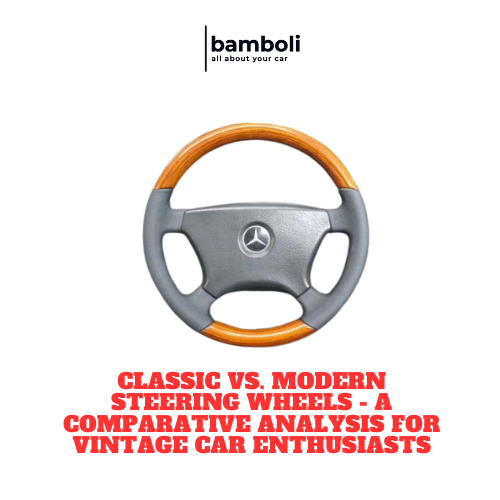Classic vs. Modern Steering Wheels - A Comparative Analysis for Vintage Car Enthusiasts

Vintage cars, one of the key components that enthusiasts often pay close attention to is the steering wheel. The Classic steering wheels of old exude a sense of nostalgia and craftsmanship, while the Modern steering wheels of today boast advanced technology and sleek designs. In this comparative analysis, we will explore the differences between classic and modern steering wheels, discussing their design, materials, and overall driving experience.
Main Points
- The design of Classic and Modern steering wheels
- The materials used in Classic and Modern steering wheels
- The driving experience of Classic and Modern steering wheels
Evolution of Steering Wheel Designs in Classic Cars
Classic cars, one of the most iconic features is the steering wheel. Over the years, the design of steering wheels has evolved significantly. Let's take a closer look at how steering wheel designs have changed in classic cars:
- Classic Wooden Steering Wheels
In the early days of classic cars, steering wheels were often made of wood. These wooden steering wheels were not only durable but also added a touch of elegance to the interior of the car.
- Rim-Blow Steering Wheels
In the 1960s and 1970s, rim-blow steering wheels became popular in classic cars. These steering wheels featured a unique design where the horn button was located on the rim of the wheel, allowing drivers to honk the horn by pressing on the rim.
- Three-Spoke Steering Wheels
By the 1980s and 1990s, three-spoke steering wheels started to become the norm in classic cars. These steering wheels featured three spokes radiating out from the center, providing a sporty and modern look.
- Modern Multifunction Steering Wheels
Today, many classic cars come equipped with modern multifunction steering wheels that include audio controls, cruise control buttons, and even paddle shifters. These steering wheels not only offer convenience but also add a tech-savvy touch to classic car interiors.
Overall, the evolution of steering wheel designs in classic cars showcases how functionality and style have continued to influence car design over the years.
Innovations in Steering Wheel Technology for Modern Vehicles
Steering wheel technology has come a long way in recent years, with manufacturers constantly innovating to enhance safety, comfort, and convenience for drivers. From advanced driver-assistance systems to integrated entertainment controls, modern steering wheels offer a wide range of features that make driving an enjoyable experience.
Key Innovations in Steering Wheel Technology
- Touch-sensitive Controls: Many modern steering wheels come equipped with touch-sensitive controls that allow drivers to easily access various functions without taking their hands off the wheel. This includes controls for audio, phone calls, navigation, and even climate settings.
- Heated Steering Wheels: In colder climates, heated steering wheels have become a popular feature in modern vehicles. These steering wheels provide a comfortable driving experience by keeping the driver's hands warm during winter months.
- Adaptive Steering Systems: Some vehicles are now equipped with adaptive steering systems that adjust the steering response based on driving conditions. This technology can provide a more precise and controlled driving experience, enhancing overall safety.
|
Feature |
Description |
|
Touch-sensitive Controls |
Allows for easy access to various functions without taking hands off the wheel |
|
Heated Steering Wheels |
Keeps driver's hands warm in colder climates |
|
Adaptive Steering Systems |
Adjusts steering response based on driving conditions for a safer driving experience |
Overall, innovations in steering wheel technology have greatly improved the driving experience, making modern vehicles safer, more comfortable, and convenient for drivers. As technology continues to advance, we can expect even more exciting developments in steering wheel technology in the future.
Ergonomics: A Critical Factor in Classic Steering Wheel Design
Classic car design, one often overlooked but crucial aspect is ergonomics. The way in which a steering wheel is designed can have a significant impact on the comfort and safety of the driver.
Ergonomics is the science of designing products and environments to be efficient, comfortable, and safe for human use. In the case of classic steering wheels, this means taking into consideration factors such as grip, size, shape, and placement. A well-designed steering wheel should allow the driver to maintain a comfortable and natural position while driving, reducing the risk of fatigue and enhancing control.
The grip of the steering wheel is critical in ensuring a secure and comfortable hold for the driver. Classic steering wheels are often designed with textured or contoured grips to prevent slipping and provide a tactile surface for better control. The size and shape of the steering wheel also play a role in ergonomics, with smaller, thicker wheels often preferred for a more comfortable grip.
Placement of the steering wheel is another key factor in classic car design. The angle and distance of the wheel from the driver should be optimized for easy reach and minimal strain on the arms and shoulders. Proper placement can also improve visibility and reduce the risk of injury in the event of a collision.
Ergonomics is a critical factor in the design of classic steering wheels. By prioritizing comfort, safety, and efficiency, designers can create steering wheels that enhance the driving experience and ensure a more enjoyable ride for classic car enthusiasts.
The Role of Advanced Materials in Modern Steering Wheels
In today's automotive industry, steering wheels are no longer just a basic component used for steering a vehicle. With the advancements in technology and materials, steering wheels have evolved to become sophisticated pieces of engineering that enhance both the functionality and the aesthetics of a car. One of the key drivers of this evolution is the use of advanced materials in the manufacturing of steering wheels.
Improved Durability
One of the primary benefits of using advanced materials in steering wheels is the improved durability they provide. Traditional steering wheels made of plastic or leather were prone to wear and tear over time, leading to a decrease in performance and aesthetics. By incorporating materials such as carbon fiber, aluminum, or magnesium alloys, manufacturers are able to create steering wheels that are not only lighter but also more resistant to scratches, fading, and overall damage.
Enhanced Comfort
Another important role of advanced materials in modern steering wheels is the enhancement of comfort for the driver. Materials like leather and suede offer a luxurious feel and improved grip, reducing fatigue during long drives. Additionally, some steering wheels feature heating elements or cooling systems made possible by advanced materials, providing a more comfortable driving experience in extreme weather conditions.
Technological Integration
Advanced materials also play a crucial role in enabling the integration of technology into steering wheels. With the rise of driver-assist systems and infotainment features in modern vehicles, steering wheels are no longer just used for steering. Materials such as touch-sensitive coatings, sensors, and even displays can be seamlessly incorporated into the design of the steering wheel, allowing for easy access to various controls without taking hands off the wheel.
Conclusion
Overall, the use of advanced materials in modern steering wheels has revolutionized the driving experience, providing improved durability, enhanced comfort, and seamless technological integration. As automotive technology continues to advance, we can expect steering wheels to become even more sophisticated and tailored to meet the needs and preferences of drivers.
Aesthetics and Functionality: Balancing Act in Classic Steering Wheels
Classic cars, one of the most essential components that often gets overlooked is the steering wheel. Not only does it serve a functional purpose, allowing the driver to navigate the vehicle, but it also plays a crucial role in the overall aesthetics of the car.
Classic steering wheels are often seen as pieces of art, with intricate designs and craftsmanship that showcase the beauty and elegance of the era in which they were produced. However, balancing aesthetics with functionality is key when it comes to these vintage wheels.
Functionality
While classic steering wheels may be visually stunning, they also need to be practical and functional. The ergonomics of the wheel are important to consider, as it should be easy and comfortable for the driver to grip and turn. Additionally, the size of the wheel should allow for smooth and precise steering, especially at high speeds.
Aesthetics
Classic steering wheels are often made from high-quality materials such as wood, leather, or metal, adding to their elegance and sophistication. The design of the wheel can also be a reflection of the overall style and aesthetic of the car, tying the interior together in a cohesive manner.
In conclusion, finding the perfect balance between aesthetics and functionality is essential when it comes to classic steering wheels. These intricate pieces not only add to the overall look of the vehicle but also play a crucial role in how the driver interacts with the car. Next time you admire a vintage car, take a moment to appreciate the beauty and craftsmanship of the steering wheel that ties it all together.
Integrating Driver-Assist Features in Modern Steering Wheels
With the rapid advancement of technology, modern vehicles are becoming equipped with more driver-assist features than ever before. One area of focus for automotive engineers is the steering wheel, which is now being utilized for more than just steering the vehicle.
"Integrating driver-assist features directly into the steering wheel can greatly improve the overall driving experience and safety of the vehicle." - Automotive Industry Expert
Some of the driver-assist features that can be integrated into modern steering wheels include:
- Adaptive Cruise Control:
By incorporating adaptive cruise control buttons or sensors into the steering wheel, drivers can easily adjust their cruising speed without taking their hands off the wheel.
- Lane Keeping Assist:
Steering wheels can now be equipped with sensors that provide feedback to the driver if they start to drift out of their lane, helping to prevent accidents caused by distracted or drowsy driving.
- Voice Command Integration:
Many modern vehicles now offer voice command features that can be accessed through the steering wheel, allowing drivers to control various functions of the vehicle without needing to take their hands off the wheel.
|
Driver-Assist Feature |
Integration in Steering Wheel |
|
Adaptive Cruise Control |
Buttons or sensors for speed adjustment |
|
Lane Keeping Assist |
Sensors for lane departure warnings |
|
Voice Command Integration |
Access to voice command features |
Maintenance and Restoration Tips for Vintage Steering Wheels
Steering wheels are not only a functional part of a vehicle, but they also contribute to the overall aesthetic of a vintage car. However, over time, vintage steering wheels can deteriorate and lose their original charm. To ensure that your vintage steering wheel remains in top condition, follow these maintenance and restoration tips:
- Clean the Steering Wheel
Regularly clean the steering wheel with a mild soap and water solution to remove dirt and grime. Avoid using harsh chemicals that can damage the material of the steering wheel.
- Condition the Steering Wheel
Apply a high-quality leather conditioner to leather steering wheels to prevent them from drying out and cracking. For wooden steering wheels, use a wood polish to maintain their shine and prevent splintering.
- Protect the Steering Wheel
When parking your vintage car, use a steering wheel cover to protect it from the sun's harmful UV rays and prevent fading. Additionally, consider storing your car in a garage to shield the steering wheel from extreme temperatures.
- Restore the Steering Wheel
If your vintage steering wheel has already started to show signs of wear and tear, consider seeking professional restoration services. A skilled technician can repair cracks, scratches, and other imperfections to restore the steering wheel to its former glory.
- Invest in a Steering Wheel Restoration Kit
If you prefer a DIY approach, invest in a steering wheel restoration kit that includes all the necessary tools and products to refurbish your vintage steering wheel. Follow the instructions carefully to achieve the best results.
- Seek Expert Advice
If you are unsure about how to properly maintain or restore your vintage steering wheel, don't hesitate to seek advice from experts in the field. They can provide valuable insights and recommendations based on their experience.
By following these maintenance and restoration tips, you can ensure that your vintage steering wheel remains a timeless and elegant feature of your classic car.




